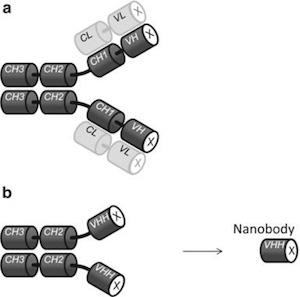Featured Projects
Alpaca nanobodies neutralise COVID-19 spike protein

Synchrotron analysis confirms tight binding of nanobodies at the molecular level.
As the SARS-CoV-2 / COVID-19 virus continues to evolve and produce new variants with high levels of transmission, ongoing vaccine development is essential.
Researchers at the Max Planck Institute for Max Planck Institute for Biophysical Chemistry have developed a new approach using nanobodies (also known as VHH antibodies) that neutralize SARS-CoV-2 before it can enter and infect cells.
Macromolecular crystallography beamlines at the Swiss Light Source were used to confirm the tight binding of the nanobodies to the spike protein of the SARS-CoV-2 virus.
The nanobodies combine extreme stability and outstanding efficacy against the virus and its Alpha, Beta, Gamma, and Delta mutants. They can withstand temperatures of up to 95°C without losing their function with potential to be produced on an industrial scale at low cost.
Single nanobodies are potentially suitable for inhaling to directly neutralise the virus in the respiratory tract. Clinical trials are being prepared.
Nanobodies attack the Sars-CoV-2 spike protein
 SARS-CoV-2 infects cells when the Receptor-Binding Domain (RBD) of the SARS-CoV-2 spike protein docks to the cell surface receptor ACE2, fusing its viral membrane with the plasma membrane of the cell under attack. A formidable challenge is that several virus mutations alter the RBD surface structure so that the virus escapes neutralisation.
SARS-CoV-2 infects cells when the Receptor-Binding Domain (RBD) of the SARS-CoV-2 spike protein docks to the cell surface receptor ACE2, fusing its viral membrane with the plasma membrane of the cell under attack. A formidable challenge is that several virus mutations alter the RBD surface structure so that the virus escapes neutralisation.
The nanobodies bind to molecular sites on the RBD blocking its binding action to prevent the virus from infecting cells. Some of the nanobodies need less than a millionth of a gram per litre to completely prevent infection.
To generate the nanobodies against SARS-CoV-2, alpacas at the MPI for Biophysical Chemistry were immunised with parts of the coronavirus spike protein. The alpacas then produced a wide pool of candidate nanobodies which were selectively narrowed down to the most effective.
References
Neutralization of SARS-CoV-2 by highly potent, hyperthermostable, and mutation-tolerant nanobodies.
Güttler T, Aksu M, Dickmanns A, Stegmann KM, Gregor K, Rees R, Taxer W, Rymarenko O, Schünemann J, Dienemann C, Gunkel P, Mussil B, Krull J, Teichmann U, Groß U, Cordes VC, Dobbelstein M, Görlich D
EMBO J (2021)40:e107985
https://doi.org/10.15252/embj.2021107985
